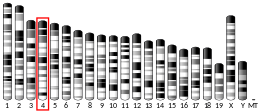EPH 수용체 A2
EPH receptor A2EPH 수용체 A2(에프린 타입-A 수용체 2)는 인간에서 EPHA2 유전자에 의해 인코딩되는 단백질이다.[5][6]
함수
이 유전자는 단백질-티로신키나아제 계열의 에프린 수용체 하위군에 속한다.EPH 및 EPH 관련 수용체는 특히 신경계통의 발달 사건을 매개하는 데 관여되어 왔다.EPH 하위 계열의 수용체들은 전형적으로 단일 키나제 영역을 가지고 있으며, 체스가 풍부한 도메인과 2개의 섬유질 타입 III를 포함하는 세포외 영역을 가지고 있다.에프린 수용체는 세포외 영역 시퀀스의 유사성과 에프린-A와 에프린-B 리간드를 결합하는 친화력을 바탕으로 두 그룹으로 나뉜다.이 유전자는 에프린-A 리간드를 결합하는 단백질을 암호화한다.[6]
임상적 유의성
BRAF 돌연변이 멜라노마가 BRAF 억제제 및 MEK 억제제에 내성을 갖게 되는 것과 관련이 있을 수 있다.[7]또한 카포시 육종 관련 헤르페스바이러스(KSHV)가 숙주세포에 침투하는 수용체로서 EphA2의 작은 분자억제제는 인간세포에 대한 KSHV의 진입을 차단하는 어느 정도 능력을 보였다.[8]
상호작용
EPH 수용체 A2는 다음과 상호작용하는 것으로 나타났다.
독사조신은 EPH 수용체 A2의 작은 분자 작용제라는 사실도 밝혀졌다.[13]
참조
- ^ a b c GRCh38: 앙상블 릴리스 89: ENSG00000142627 - 앙상블, 2017년 5월
- ^ a b c GRCm38: 앙상블 릴리스 89: ENSMUSG00000006445 - 앙상블, 2017년 5월
- ^ "Human PubMed Reference:". National Center for Biotechnology Information, U.S. National Library of Medicine.
- ^ "Mouse PubMed Reference:". National Center for Biotechnology Information, U.S. National Library of Medicine.
- ^ Sulman EP, Tang XX, Allen C, Biegel JA, Pleasure DE, Brodeur GM, Ikegaki N (April 1997). "ECK, a human EPH-related gene, maps to 1p36.1, a common region of alteration in human cancers". Genomics. 40 (2): 371–4. doi:10.1006/geno.1996.4569. PMID 9119409.
- ^ a b "Entrez Gene: EPHA2 EPH receptor A2".
- ^ "Counteracting Drug Resistance in Melanoma". 2015.
- ^ Hahn AS, Kaufmann JK, Wies E, Naschberger E, Panteleev-Ivlev J, Schmidt K, Holzer A, Schmidt M, Chen J, König S, Ensser A, Myoung J, Brockmeyer NH, Stürzl M, Fleckenstein B, Neipel F (2012). "The ephrin receptor tyrosine kinase A2 is a cellular receptor for Kaposi's sarcoma–associated herpesvirus". Nat. Med. 18 (6): 961–6. doi:10.1038/nm.2805. PMC 3645317. PMID 22635007.
- ^ Himanen JP, Goldgur Y, Miao H, Myshkin E, Guo H, Buck M, Nguyen M, Rajashankar KR, Wang BC, Nikolov DB (July 2009). "Ligand recognition by A-class Eph receptors: crystal structures of the EphA2 ligand-binding domain and the EphA2/ephrin-A1 complex". EMBO Rep. 10 (7): 722–8. doi:10.1038/embor.2009.91. PMC 2727437. PMID 19525919.
- ^ Kikawa KD, Vidale DR, Van Etten RL, Kinch MS (October 2002). "Regulation of the EphA2 kinase by the low molecular weight tyrosine phosphatase induces transformation". J. Biol. Chem. 277 (42): 39274–9. doi:10.1074/jbc.M207127200. PMID 12167657.
- ^ a b Pratt RL, Kinch MS (October 2002). "Activation of the EphA2 tyrosine kinase stimulates the MAP/ERK kinase signaling cascade". Oncogene. 21 (50): 7690–9. doi:10.1038/sj.onc.1205758. PMID 12400011.
- ^ Pandey A, Lazar DF, Saltiel AR, Dixit VM (December 1994). "Activation of the Eck receptor protein tyrosine kinase stimulates phosphatidylinositol 3-kinase activity". J. Biol. Chem. 269 (48): 30154–7. doi:10.1016/S0021-9258(18)43790-8. PMID 7982920.
- ^ Petty A, Myshkin E, Qin H, Guo H, Miao H, Tochtrop GP, Hsieh JT, Page P, Liu L, Lindner DJ, Acharya C, MacKerell AD, Ficker E, Song J, Wang BC (August 2012). "A small molecule agonist of EphA2 receptor tyrosine kinase inhibits tumor cell migration in vitro and prostate cancer metastasis in vivo". PLOS ONE. 7 (8): e42120. doi:10.1371/journal.pone.0042120. PMC 3419725. PMID 22916121.
추가 읽기
- Flanagan JG, Vanderhaeghen P (1998). "The ephrins and Eph receptors in neural development". Annu. Rev. Neurosci. 21: 309–45. doi:10.1146/annurev.neuro.21.1.309. PMID 9530499. S2CID 1278600.
- Zhou R (1998). "The Eph family receptors and ligands". Pharmacol. Ther. 77 (3): 151–81. doi:10.1016/S0163-7258(97)00112-5. PMID 9576626.
- Holder N, Klein R (1999). "Eph receptors and ephrins: effectors of morphogenesis". Development. 126 (10): 2033–44. doi:10.1242/dev.126.10.2033. PMID 10207129.
- Wilkinson DG (2000). "Eph receptors and ephrins: regulators of guidance and assembly". Int. Rev. Cytol. International Review of Cytology. 196: 177–244. doi:10.1016/S0074-7696(00)96005-4. ISBN 9780123646002. PMID 10730216.
- Xu Q, Mellitzer G, Wilkinson DG (2000). "Roles of Eph receptors and ephrins in segmental patterning". Philos. Trans. R. Soc. Lond. B Biol. Sci. 355 (1399): 993–1002. doi:10.1098/rstb.2000.0635. PMC 1692797. PMID 11128993.
- Wilkinson DG (2001). "Multiple roles of EPH receptors and ephrins in neural development". Nat. Rev. Neurosci. 2 (3): 155–64. doi:10.1038/35058515. PMID 11256076. S2CID 205014301.
- Kinch MS, Carles-Kinch K (2003). "Overexpression and functional alterations of the EphA2 tyrosine kinase in cancer". Clin. Exp. Metastasis. 20 (1): 59–68. doi:10.1023/A:1022546620495. PMID 12650608. S2CID 2472961.
- Walker-Daniels J, Hess AR, Hendrix MJ, Kinch MS (2003). "Differential regulation of EphA2 in normal and malignant cells". Am. J. Pathol. 162 (4): 1037–42. doi:10.1016/S0002-9440(10)63899-0. PMC 1851246. PMID 12651595.
- Lindberg RA, Hunter T (1990). "cDNA cloning and characterization of eck, an epithelial cell receptor protein-tyrosine kinase in the eph/elk family of protein kinases". Mol. Cell. Biol. 10 (12): 6316–24. doi:10.1128/mcb.10.12.6316. PMC 362907. PMID 2174105.
- Pandey A, Shao H, Marks RM, Polverini PJ, Dixit VM (1995). "Role of B61, the ligand for the Eck receptor tyrosine kinase, in TNF-alpha-induced angiogenesis". Science. 268 (5210): 567–9. Bibcode:1995Sci...268..567P. doi:10.1126/science.7536959. PMID 7536959.
- Pandey A, Duan H, Dixit VM (1995). "Characterization of a novel Src-like adapter protein that associates with the Eck receptor tyrosine kinase". J. Biol. Chem. 270 (33): 19201–4. doi:10.1074/jbc.270.33.19201. PMID 7543898.
- Ruiz JC, Robertson EJ (1994). "The expression of the receptor-protein tyrosine kinase gene, eck, is highly restricted during early mouse development". Mech. Dev. 46 (2): 87–100. doi:10.1016/0925-4773(94)90078-7. PMID 7918100. S2CID 21419336.
- Davis S, Gale NW, Aldrich TH, Maisonpierre PC, Lhotak V, Pawson T, Goldfarb M, Yancopoulos GD (1994). "Ligands for EPH-related receptor tyrosine kinases that require membrane attachment or clustering for activity". Science. 266 (5186): 816–9. Bibcode:1994Sci...266..816D. doi:10.1126/science.7973638. PMID 7973638.
- Pandey A, Lazar DF, Saltiel AR, Dixit VM (1994). "Activation of the Eck receptor protein tyrosine kinase stimulates phosphatidylinositol 3-kinase activity". J. Biol. Chem. 269 (48): 30154–7. doi:10.1016/S0021-9258(18)43790-8. PMID 7982920.
- Ganju P, Shigemoto K, Brennan J, Entwistle A, Reith AD (1994). "The Eck receptor tyrosine kinase is implicated in pattern formation during gastrulation, hindbrain segmentation and limb development". Oncogene. 9 (6): 1613–24. PMID 8183555.
- Gale NW, Holland SJ, Valenzuela DM, Flenniken A, Pan L, Ryan TE, Henkemeyer M, Strebhardt K, Hirai H, Wilkinson DG, Pawson T, Davis S, Yancopoulos GD (1996). "Eph receptors and ligands comprise two major specificity subclasses and are reciprocally compartmentalized during embryogenesis". Neuron. 17 (1): 9–19. doi:10.1016/S0896-6273(00)80276-7. PMID 8755474. S2CID 1075856.
- Kozlosky CJ, VandenBos T, Park L, Cerretti DP, Carpenter MK (1997). "LERK-7: a ligand of the Eph-related kinases is developmentally regulated in the brain". Cytokine. 9 (8): 540–9. doi:10.1006/cyto.1997.0199. PMID 9245480.
- Ephnomenclaturecommittee (1997). "Unified nomenclature for Eph family receptors and their ligands, the ephrins. Eph Nomenclature Committee". Cell. 90 (3): 403–4. doi:10.1016/S0092-8674(00)80500-0. PMID 9267020. S2CID 26773768.
외부 링크
- PDBe-KB에서 UniProt: P29317(Human Ephrin type-A 수용체 2)에 대한 PDB의 모든 구조 정보 개요.
- PDBe-KB에서 UniProt: Q03145(Mouse Ephrin type-A 수용체 2)에 대한 PDB의 모든 구조 정보 개요.









